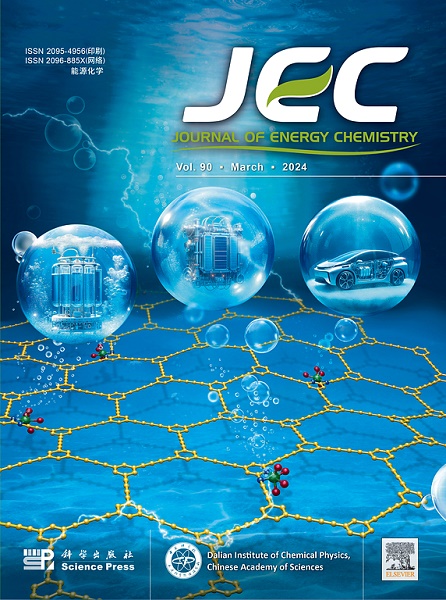Enhancing d-p orbital hybridization through oxygen vacancies boosting capacity and kinetics of layered double hydroxides for durable aqueous magnesium-ion batteries
IF 13.1
1区 化学
Q1 Energy
引用次数: 0
Abstract
Layered double hydroxides (LDHs) are potential cathode materials for aqueous magnesium-ion batteries (AMIBs). However, the low capacity and sluggish kinetics significantly limit their electrochemical performance in AMIBs. Herein, we find that oxygen vacancies can significantly boost the capacity, electrochemical kinetics, and structure stability of LDHs. The corresponding structure-performance relationship and energy storage mechanism are elaborated through exhaustive in/ex-situ experimental characterizations and density functional theory (DFT) calculations. Specially, in-situ Raman and DFT calculations reveal that oxygen vacancies elevate orbital energy of O 2p and electron density of O atoms, thereby enhancing the orbital hybridization of O 2p with Ni/Co 3d. This facilitates electron transfer between O and adjacent Ni/Co atoms and improves the covalency of Ni–O and Co–O bonds, which activates Ni/Co atoms to release more capacity and stabilizes the Ov-NiCo-LDH structure. Moreover, the distribution of relaxation times (DRT) and molecular dynamics (MD) simulations disclose that the enhanced d-p orbital hybridization optimizes the electronic structure of Ov-NiCo-LDH, which distinctly reduces the diffusion energy barriers of Mg2+ and improves the charge transfer kinetics of Ov-NiCo-LDH. Consequently, the assembled Ov-NiCo-LDH//active carbon (AC) and Ov-NiCo-LDH//perylenediimide (PTCDI) AMIBs can both deliver high specific discharge capacity (182.7 and 59.4 mAh g−1 at 0.5 A g−1, respectively) and long-term cycling stability (85.4% and 89.0% of capacity retentions after 2500 and 2400 cycles at 1.0 A g−1, respectively). In addition, the practical prospects for Ov-NiCo-LDH-based AMIBs have been demonstrated in different application scenarios. This work not only provides an effective strategy for obtaining high-performance cathodes of AMIBs, but also fundamentally elucidates the inherent mechanisms.

通过氧空位增强d-p轨道杂化,增强持久水镁离子电池层状双氢氧化物的容量和动力学
层状双氢氧化物是水镁离子电池极具潜力的正极材料。然而,低容量和缓慢的动力学极大地限制了它们在amib中的电化学性能。本研究发现,氧空位可以显著提高LDHs的容量、电化学动力学和结构稳定性。通过详尽的原位/非原位实验表征和密度泛函理论(DFT)计算,阐述了相应的结构-性能关系和储能机理。特别地,原位拉曼和DFT计算表明,氧空位提高了O 2p的轨道能量和O原子的电子密度,从而增强了O 2p与Ni/Co 3d的轨道杂化。这促进了O和相邻Ni/Co原子之间的电子转移,提高了Ni - O和Co- O键的共价,从而激活Ni/Co原子释放更多的容量,稳定了Ov-NiCo-LDH结构。此外,弛豫时间(DRT)分布和分子动力学(MD)模拟表明,增强的d-p轨道杂化优化了Ov-NiCo-LDH的电子结构,明显降低了Mg2+的扩散能垒,改善了Ov-NiCo-LDH的电荷转移动力学。因此,组装的Ov-NiCo-LDH//活性炭(AC)和Ov-NiCo-LDH//苝酰亚胺(PTCDI) AMIBs均具有较高的比放电容量(0.5 A g−1时分别为182.7和59.4 mAh g−1)和长期循环稳定性(1.0 A g−1时分别为2500和2400次循环后的容量保留率分别为85.4%和89.0%)。此外,还在不同的应用场景中展示了基于ov - nico - ldh的amib的实际应用前景。这项工作不仅为获得高性能amib阴极提供了有效的策略,而且从根本上阐明了其内在机制。
本文章由计算机程序翻译,如有差异,请以英文原文为准。
求助全文
约1分钟内获得全文
求助全文
来源期刊

Journal of Energy Chemistry
CHEMISTRY, APPLIED-CHEMISTRY, PHYSICAL
CiteScore
19.10
自引率
8.40%
发文量
3631
审稿时长
15 days
期刊介绍:
The Journal of Energy Chemistry, the official publication of Science Press and the Dalian Institute of Chemical Physics, Chinese Academy of Sciences, serves as a platform for reporting creative research and innovative applications in energy chemistry. It mainly reports on creative researches and innovative applications of chemical conversions of fossil energy, carbon dioxide, electrochemical energy and hydrogen energy, as well as the conversions of biomass and solar energy related with chemical issues to promote academic exchanges in the field of energy chemistry and to accelerate the exploration, research and development of energy science and technologies.
This journal focuses on original research papers covering various topics within energy chemistry worldwide, including:
Optimized utilization of fossil energy
Hydrogen energy
Conversion and storage of electrochemical energy
Capture, storage, and chemical conversion of carbon dioxide
Materials and nanotechnologies for energy conversion and storage
Chemistry in biomass conversion
Chemistry in the utilization of solar energy
 求助内容:
求助内容: 应助结果提醒方式:
应助结果提醒方式:


